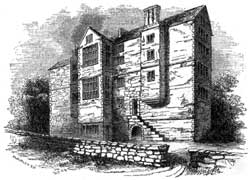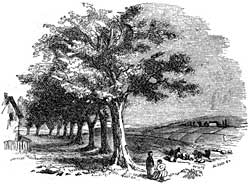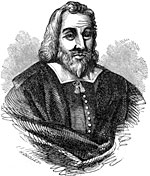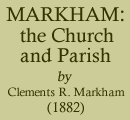< Previous | Contents | Next >
XII.—Markhams of Cotham and Ollerton.
The descendants of the elder brother of the Chief Justice, Sir Robert Markham, continued to hold possession of East Markham for seven generations, although, after the marriage of Sir Robert with the heiress of Sir Giles Daubeny, they made Cotham their chief seat, a place about six miles south of Newark. It was from Cotham that Sir John Markham led his retainers to take part in the battle of Stoke in 1488. But this Sir John was "an unrulie spirited man", and striving with the people of Long Benington about boundaries, he very imprudently hanged the priest. He consequently had to conceal himself at Cressy Hall, where he had the good fortune to entertain the Lady Margaret, mother of Henry VII. This not only led to a pardon, but also to a marriage between his son John and a daughter of Sir George Neville, a young lady of the blood of Lancaster, and kinswoman of the King. At this period the Markham family was at the height of its fortunes.
It is recorded that, in 1502, when the Princess Margaret was on her progress to Scotland, to marry King James IV, Lincoln Minster came in sight as the cavalcade reached the top of the hill near Markham village. The Princess immediately descended from her palfrey and the whole procession knelt down, and joined in prayer and thanksgiving.

Worksop Lodge.

Site of the House at Cotham.
The younger Sir John Markham was an able and intrepid military commander. He distinguished himself in an international tournament under the walls of Terouenne in 1543, was in charge of the Scottish border, held a command at the battle of Pinkey, and was Lieutenant-Governor of the Tower in 1550. He died in 1564. One of his younger sons, Thomas Markham, founded the branch of Markhams of Ollerton, which became extinct in 1760. It numbered among its scions the restless conspirator, Sir Griffin Markham; Colonel Thomas Markham, who was mortally wounded at the fight of Gainsborough on the King's side in July 1643; and Margaret, the Abbess of Pontoise, who died in 1717, in her 105th year. Another scion of the Ollerton branch was George Markham, maternal grandfather of the Archbishop of York, who settled at Worksop Lodge in 1670. This quaint old building, now the property of the Duke of Newcastle, is still standing, and is used as a farmhouse, known as the Lodge Farm. The accompanying sketch shows its appearance in 1837, but it is now covered with masses of ivy.
Sir John Markham's daughter Isabella was maid of honour to the Princess Elizabeth at Hatfield, and for many years afterwards, of the bedchamber, and a valued friend of the great Queen. She married the faithful John Harington, and was the mother of Sir John Harington, the brilliant and accomplished courtier, whom Elizabeth used to call her "witty godson".
Sir John was succeeded at East Markham and Cotham by his grandson Robert Markham, who was constantly about the Court of Elizabeth, and therefore "a valiant consumer of his paternal inheritance". His letters to his cousin Harington show that he had a very shrewd insight into the complicated intrigues of those times. He was in considerable repute with his royal mistress, and was a stout man at arms, earning for himself a place in that distich of the maiden queen, in which she celebrated her four Nottinghamshire courtiers:—
Robert Markham died in 1606, and his son, Sir Robert Markham, was the last possessor of East Markham and Cotham. The great house at Cotham has entirely disappeared; for the courtier lives of father and son brought a strain on the Nottinghamshire estates which was too heavy for them to bear. Sir Robert is described by Thoroton as "a fatal unthrift and destroyer of this eminent family". He dissipated the whole of the great patrimony which descended to him from his ancestors. East Markham was sold partly to Robert Williamson and partly to William Hewet.

Gervase Markham.
Sir Robert, the last possessor, had three eminent brothers. Francis was an antiquary, and also did good service with the Queen's forces in the Low Countries, and in Ireland. He wrote the Book of Honour, Decades of Epistles of War, a history of the Markham Family, and a most entertaining memoir of his own life and adventures. Latterly he was Muster-Master for Nottinghamshire, and, dying in 1627, he was buried at Boston. Gervase Markham, the next brother, was a most prolific author, as well as a soldier, who saw much service in the Low Countries. He was a poet, a dramatist, and a writer on agriculture, gardening, angling, horsemanship, archery, and kindred subjects. He introduced one of the first Arabs into this country, which he sold to James I for £100. Gervase was also a good linguist, and an indefatigable student. He died at the age of seventy, in February 1637, and lies buried in the church of St. Giles Cripplegate. Godfrey Markham, the youngest, was in the Royalist garrison at Newark, and was slain during a very gallant sortie, in the early part of 1644.
XIII.—Pilgrimages of Descendants to Markham Church.
With these brothers, the direct connection between East Markham and the family which had its origin in the upland village, and had lived there for so many centuries, finally ceased. But in later times a descendant, Dr. William Markham, from being Archbishop of York from 1777 to 1807, became connected with Nottinghamshire officially, and especially with Southwell. The Archbishop's descendants have, in each generation, shown the interest they take in the home of their ancestors by occasional visits to the old church. His third son George, when quite a young man, made a pilgrimage to Markham Church in 1784, and carefully copied the inscription on the Judge's tomb. This was fortunate, for he thus preserved one of the words which is now obliterated. He says, in a manuscript note, "It was plainly 'S. Silvestri papas'* when I saw it". Nearly twenty years afterwards George Markham became Dean of York, and in that high office he was enabled to carry out extensive and solid repairs of the fabric of the minster, and so to improve the vicinity as to make the glorious pile assume, in its exterior, the appearance which it now presents. The Dean died in 1822. His daughters Henrietta and Sarah visited Markham on July 29th, 1861, and made a pencil-sketch of the church. In 1831 the Rev. David F. Markham, Canon of Windsor and Rector of Great Horkesley, visited Markham Church, and made careful drawings of the font, the lid of the stone coffin mentioned at page 14, the altar tomb, and copied the inscription, when the word papas, clearly deciphered by his uncle, the Dean, in 1784, was no longer legible. Mr. Markham was the author of a History of the Markham Family, which was printed after his lamented death in 1853. His son made pilgrimages to Markham Church on December 22nd, 1864, March 13th, 1874, and March 29th, 1882.
XIV.—Williamsons of East Markham.
The last Markham of Markham sold his estates in East Markham to William Hewet and Robert Williamson. This Hewet was probably of the same family with the Lord Mayor, from the marriage of whose daughter with young Osborne, the apprentice, the Dukes of Leeds descend. The Williamsons are said to have lived in a manor-house on the east side of the church. Thomas, the son of the purchaser, was created a baronet in 1642, and his grandson married an heiress named Elizabeth Hedworth, and removed to Durham.
There are stones in the chancel floor inscribed to the memories of Robert Williamson and of Sir Thomas Williamson. The family of Sir Hedworth Williamson has long ceased to have any connection with East Markham.
XV.—Plague and Civil War.
A market was formerly held at East Markham, and there was an old market cross on a grassy eminence near the church, the centre of a rising and flourishing town. But a terrible calamity checked its prosperity in the early part of the seventeenth century. A malignant fever, or plague, as it was called, broke out at Markham in 1609, which devastated the village. There were as many as one hundred and fifteen deaths in the course of the year, the last being that of the clergyman, the Rev. William Field. It was many years before Markham recovered from this visitation, and in the interval, the next village of Tuxford gradually took its place, and became a market town, Tuxford had the advantage of being on the great north road, while Markham is a short distance to the eastward of it.
Mr. Field was succeeded as vicar by the Rev. John Savage, who was followed in 1618 by the Rev. George Ormerod. It was in Mr. Ormerod's time that the existing fine peal of bells was placed in the church tower. They all bear the date of 1637.
During the Civil War, no military event, the memory of which has been preserved, occurred at Markham, although the great north road passes over Markham Moor, which is only a mile from the north-west end of the village. A battle was fought not many miles away, at Gainsborough, on July 28th, 1643, when Colonel Cavendish and Colonel Markham of Ollerton were slain on the Royalist side; and the three sieges of Newark, from 1644 to May 1646, must have kept the neighbouring country in an unsettled state. The clergymen at Markham during the troubles were William Holland and John Burton, and against their names in the register is the entry "both left, et per lessionem".
XVL—Visit of King William III.
Later in the seventeenth century, the Rev. Nathan Kirkby was Vicar of East Markham from 1684 to 1709, and he made several interesting entries in the register. On October 30th, 1695, he loyally recorded a memorable visit, when "King William III came from Lincoln, through Great Markham, in his progress to Welbeck". That seat then belonged to John Holles, Earl of Clare, who had been created Duke of Newcastle in the previous year, and it was his grand-daughter who brought it to the Bentincks. On his way to Lincoln his Majesty stopped at Belton with Sir John Brownlow, and got "very fresh". The account says: "The King was exceedingly merry there, and drank very freely, which was the occasion, when he came to Lincoln, he could take nothing but a porringer of milk. From Lincoln, after prayers in the cathedral, he proceeded in his coach to Welbeck."
XVII.—The Kirkes of East Markham.
The family of Kirke, which had long been settled at Anston, in the parish of Laughton-en-le-Morthen, came to Markham in 1681. John Kirke of Anston purchased Mirfield Hall in East Markham from a Mr. Laughton of Scotter in Lincolnshire. He died in 1710, aged fifty-eight. There is a stone to his memory in the chancel floor; and others to his grandsons William Kirke who died in 1773, and Edmund Kirke in 1786. His son John Kirke, J.P. for Notts, born 1679, was succeeded by his son William, born 1715. The latter served under the Duke of Cumberland at the battle of Culloden. John Kirke, son of William, was Captain in the 24th light Dragoons, and afterwards Colonel of the 3rd Notts Local Militia and Retford Rifle Volunteers, which latter corps he raised. Mirfield Hall was sold to the Cartwright family in 1780. Colonel Kirke died in 1826. One of his daughters, Diana, married the Rev. T. W. Wrench; and another, Mary, is the wife of Charles Thorold, Esq., of Welham, near Retford. The eldest son, William Kirke, was born in 1799, and married Anne, daughter of Sir Thomas White, Bart., of Wallingwells, by whom he had a son John Henry, and a daughter Ann Eliza, married to E. M. Wrench, Esq. He re-purchased Mirfield Hall from the Cartwrights in 1835, and died in 1843. Colonel John Henry Kirke of Mirfield Hall, the present Lord of the Manor of East Markham, was bom in 1833. He entered the army in 1854, and served in the 19th regiment at the siege of Sebastopol, and in India during the mutinies. In 1863 he married Flora, daughter of Ormsby Jones, Esq., of Streeda, J.P. for County Sligo, and has four daughters. The present red brick house, the seat of Colonel Kirke at East Markham, was partly rebuilt by his father.
XVIII.—Mrs. Markham's "History of England".
There was also a family of Cartwrights at East Markham. They had possession of Mirfield Hall, in the village, from 1780 to 1835. Throsby, in his edition of Thoroton, mentions that they had a good mansion there in 1797, where the sisters and daughter of that eminent inventor, Dr. Cartwright, lived. Dr. Edmund Cartwright himself was born at the neighbouring village of Marnham in 1743, and went to Oxford in 1760. He became a Fellow of Magdalen College, and settled at Doncaster in 1779. This talented mechanician invented the power-loom in 1785; and in 1793 he took out a patent for carding wool. He received a grant of £10,000 from Parliament in 1809, as a reward for his mechanical inventions, and died on October 30th, 1823.
One of Dr. Cartwright's daughters was brought up at East Markham, which was the home of her childhood. She lived with her two aunts, Miss Cartwrights, at Mirfield Hall She inherited her father's ability, which she displayed in her literary labours. Miss Cartwright married the Rev. John Penrose, son of the incumbent of Fledborough. He became Vicar of Bracebridge, near Lincoln, immediately after his marriage. Here Mrs. Penrose wrote that conversational history of England, which has since become so popular. Her reason for adopting the nom de plume of "Mrs. Markham" was her attachment to the old home of her unmarried life at East Markham. Mrs. Penrose first published her book through Constable of Edinburgh in 1823, and it was a complete failure. Fortunately, it was seen by Mr. John Murray, who at once perceived its merits, and he showed remarkable sagacity and judgment in purchasing Mr. Constable's interest in it. It was republished in 1827, and under Mr. Murray's auspices Mrs. Markham's History of England became a great and permanent success. The History of France followed, but Mrs. Penrose did not long survive the full reward of her literary labours. She died on January 24th, 1837, aged 57, and was buried in the cloisters of Lincoln Cathedral Later editions of her works were revised by her husband. She left several children who inherited the talent of their mother. One of her sons, Mr. Francis Cranmer Penrose, received his second name in remembrance of the good Archbishop, from whose sister the Cartwrights were descended. He is an eminent architect, and author of a work on the principles of Athenian architecture. Mrs. Penrose is certainly the most distinguished inhabitant that East Markham has produced in modern times. Her aunts, the Miss Cartwrights, lived to very advanced ages. Catharine, the elder, was 97, and the younger, Frances, 92, at the time of their deaths. Their servant, Job Marple, who was with them for 50 years, died at the age of 98. These instances of longevity are proofs of the exceptional healthiness of Markham village.
XIX—Neglect and Desecration of the Church.
The last and early part of the present century was a period of neglect and barbarism for Markham Church. Unsightly pews were erected; most of the stained glass was broken or purloined; the fine western arch was bricked up, and a brick chimney was built up the rood loft turret. The tomb of Judge Markham does not appear to have been moved from the centre of the chancel, as conjectured by Throsby, writing in 1797. For Sir Robert Markham of Sedgebrook says that it was placed against the north wall, its present position, when he visited the church in 1680. But names have been cut on the soft gypsum, one slab is broken, and the tomb has otherwise been sadly defaced. The stone coffin, with its carved lid, was dug up and thrown into the churchyard before Throsby's time, who figures it in his edition of Thoroton. The lid was left for many years, leaning against the south wall of the chancel. The Rev. David F. Markham saw it there, and made a careful sketch of it in 1831. He then received the account of the coffin, with its bones, having been desecrated, from the sexton who repeated the parish tradition. The coffin-lid has since disappeared. The whole fabric of the church, and especially the aisles, the walls of which are leaning outwards, is in urgent need of thorough repair.
XX.—Succession of Vicars.
The Parish Registers of East Markham commence from 1561. The list of Vicars, from 1573, is as follows:-
| Thomas Marce | died 1573. | |
| 1573.- | Richard Stoke | „ 1584. |
| 1584.- | William Field | „ 1610. |
| 1610.- | John Savage | „ 1618. |
| 1618.- | George Ormerod | „ 1638. |
| 1638.- | {William Holland | } both left, et |
| {John Burton | } per lessionem. | |
| 1663.- | John Birch | died at Manchester. |
| 1681.- | James Birch | „ 1681. |
| 1682.- | Samuel Gatliff. | |
| Nathan Kirkby | „ 1709. | |
| 1709.- | Thomas Gylby. | |
| (A gap between 1739 and 1797.) | ||
| 1797.- | William Cheales. | |
| 1811.- | Sherard Becher, B.D.** | ......died 1852. |
| 1852.- | George William Brameld, M.A.† | |
The great tithes and presentation of East Markham church were granted to the Earl of Shrewsbury by Edward VI in 1553. From him they have descended, by inheritance, to the Duke of Newcastle, who is now the patron of the living, and principal landholder in the parish. The Duke is descended from Judge Markham, the former Lord of East Markham and probable founder of the present church, through his daughter Adela. The Dukes of Newcastle inherit from the family of Holles, Earls of Clare. The first Earl purchased a good deal of the Markham property, thus increasing his own estate of Houghton, which once belonged to the Stanhopes.
The vicarage of East Markham is united with that of West Drayton, a small parish of six hundred and fifty-three acres, on the Idle. The little Norman church, dedicated to St. Paul, at West Drayton, was restored in 1874, through the active support of Mr. Gladstone, who was then officiating as trustee of the Duke of Newcastle's unentailed estates.
XXI.—The Modern Village.
The area of East Markham parish is 2,820 acres,and the population was 816 in the census of 1871, inhabiting 186 houses. The village stretches away north-westward from the church for some distance, and consists of well-built comfortable houses, most of them new, with fruit gardens behind. The place is famous for its plums, great quantities being sent to Bradford and Sheffield. There are few old houses. At the further end of the village there is a farm-house called the "Hall", with spacious cellars. It may have been the house belonging to the manor held by the Lynehams; as the old house, near the church, was that of the Cressys and Markhams. There is also one curious house of wattle and daub, with strong timbers at the angles, on a stone foundation, and a thatch roof. Mason bees inhabit the mud-walls, and fly hither and thither about them, in the sunshine.
The largest modern building in East Markham is the spacious and admirably-designed Board School, the foundation stone of which was laid by Mr. Brameld, the Vicar, in 1873. It is intended for one hundred and eighty-six children, who are thoroughly well taught by Mr. Ingram, the master, for whom a good house is provided, with a garden. The natives of this Nottinghamshire village are the successors of many generations, which, from time to time, and more frequently than elsewhere, have numbered among them worthies who have risen above the common herd. Markham has produced two great constitutional lawyers, eminent statesmen and gallant soldiers, scholars and poets, a talented inventor, and one of the most popular historians of modern times. It is no small advantage, when rightly considered, for a village to possess this record; and the young people of Markham should be reminded and taught that they have equal or greater advantages, and that they, too, should strive to uphold the fame of their native place. It was so loved by one who lived there, that she adopted it as her literary name, and made it a household word wherever the English language is spoken.
XXII.—Conclusion.
No doubt there is plenty of self help among the people of East Markham. But there are occasions when help is needed from without, and there is such an occasion now. The church is in want of thorough repair and restoration. Such a church as that of Markham is a national monument. It illustrates the history of the parish during several centuries, and forms a landmark, the preservation of which is not a question of merely local interest. Its restoration may, therefore, be looked forward to as a work which will be cheerfully undertaken and actively proceeded with. It is the pride of this generation that it has, in numerous instances, made up for the neglect and vandalism of former times. It will be so in the case of Markham Church, the last resting-place of the upright and intrepid Judge. A parish church, in England, is a monument of the taste and feelings, the thoughts and habits, of those who lived and died around it during former centuries; and it should, therefore, be a centre of interest and of affectionate regard to the living generation.
* Sir Robert Markham of Sedgebrook copied the inscription in 1680, and also has "Sci. Silvestri papae". (See his Pocket Book in the British Museum.)
** He was aged 79. There is a mural tablet to his memory, on the south wall of the chancel. Fellow of St. John's College, Cambridge.
† Of Lincoln College, Oxford; took his degree, with honours, 1839, and Priest's Orders 1841. Author of Poems for Children (1849), Practical Sermons (1852-58), New Translation of the Gospels (1863).
